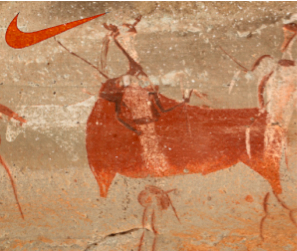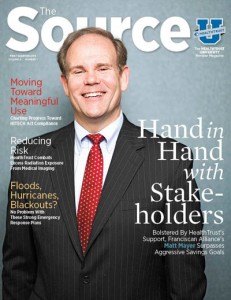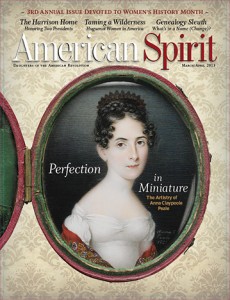



Paleolithic-era Branded Content
(Post by Rex Hammock)
When I first started blogging 13 years ago, I thought I’d attempt to correct the misperception that there’s something new about companies creating informative, high-quality and helpful media for customers. Back then, the conventional wisdom among media and marketing reporters (and most marketers) was that companies communicate with customers by purchasing advertising in media that other companies own, not via media they own.
But I knew the truth: Media created by companies for their customers has been around since Fred Flintstone invented it.
 While Rex Hammock was in Oxford, Mississipi earlier this week (see previous post), Mr. Magazine Samir Husni interviewed Rex and posted a couple of “Mr. Magazine Minutes”–Rex’s answers to a couple of questions.
While Rex Hammock was in Oxford, Mississipi earlier this week (see previous post), Mr. Magazine Samir Husni interviewed Rex and posted a couple of “Mr. Magazine Minutes”–Rex’s answers to a couple of questions.
On his blog, Professor Husni wrote:
“You can call Rex Hammock, the founder and chief executive officer of the Nashville-based Hammock Inc., any name you want, except that of a Luddite. Rex bought his first Apple Mac in 1984, and has been tempted by the Apple ever since. On Twitter he is simply known as @R. He is all over the web, the digital sphere and more.
So when Rex came to speak to my magazine students at the Meek School of Journalism and New Media yesterday, I seized the opportunity to ask him two questions, after he completed his presentation to the students.
Here are Rex’s two Mr. Magazine minute videos. (If you are on the front of the Hammock Blog, click through to see the videos)
When he was young, Samir Husni discovered that he loved magazines so much, he started collecting the first issue of every new magazine he could find. Today, that passion has grown into a one-of-a-kind collection of magazine first issues that takes up space the size of a warehouse.
His passion for magazine launches, and magazines in general, inspired him to pursue a PhD in magazine-ology (although, technically, it was called journalism from the University of Missouri-Columbia) and, ultimately, to become recognized as the leading expert on magazine launches. Today, he is noted for his annual Guide to Magazine Launches in the U.S. (there were 678 in 2012) and is director of the Magazine Innovation Institute at the Meek School of Journalism and New Media at the University of Mississippi, where he is professor and Hederman Lecturer.
Samir is also very funny, so we’re not surprised that somehow he and Hammock founder Rex Hammock discovered each other and have become friends over the years.
While Rex is known for embracing (or at least, experimenting with) any media platform he believes can help companies and other organizations build tight relationships with customers (or members, etc.), it’s no secret that Rex is a DNA-level magazine guy.
You know how some people can talk about sports and remember who pitched in the third game of some long-ago World Series? If you’re ever around Samir and Rex when they get together, they start having one of those kind of wonky conversations about magazines.
Once every couple of years, Samir invites Rex to come to Oxford to speak with students who are in his magazine development and magazine business courses. Earlier this week, Rex made one of those treks and we have the photos to prove it.
 Hammock partners with HealthTrust, one of the country’s leading health-care group purchasing organizations, to publish The Source, a quarterly magazine for supply chain managers, health-care executives, pharmacists and clinicians from a variety of disciplines. Q1’s cover story featured Matt Mayer of Franciscan Alliance, who, with HealthTrust’s help, was able to save $28 million in supply chain costs in 2012.
Hammock partners with HealthTrust, one of the country’s leading health-care group purchasing organizations, to publish The Source, a quarterly magazine for supply chain managers, health-care executives, pharmacists and clinicians from a variety of disciplines. Q1’s cover story featured Matt Mayer of Franciscan Alliance, who, with HealthTrust’s help, was able to save $28 million in supply chain costs in 2012.
Finding members such significant savings, especially in today’s squeezed health-care environment, is one of HealthTrust’s biggest priorities. The magazine’s aim is to showcase practical strategies and best practices for duplicating those kinds of success stories in hospitals and care facilities nationwide.
HealthTrust members receive the print edition, but anyone can view archives since 2008 on The Source‘s website. Take a look at the entire Q1 issue here.
 American Spirit, the national magazine of the Daughters of the American Revolution (DAR)*, has a strong track record of bringing to light stories about brave and groundbreaking women of history whose lives aren’t very familiar to most people.
American Spirit, the national magazine of the Daughters of the American Revolution (DAR)*, has a strong track record of bringing to light stories about brave and groundbreaking women of history whose lives aren’t very familiar to most people.
Nowhere is that focus more apparent than in the magazine’s third annual issue devoted to Women’s History Month.
The cover feature looks at the lives of Anna Claypoole Peale and Sarah Miriam Peale. The sisters not only found distinction as highly skilled 19th-century portrait artists, but they also were remarkable in another respect: They were able to support themselves financially in an age when women were supposed to be homemakers, not artisans.
Though Irish immigrant Margaret Haughery’s early life was marred by tragedy and she had no formal schooling, she persevered to become a successful entrepreneur in 19th-century New Orleans. This issue includes a feature examining how she dedicated her life to helping orphans in that disease-plagued city, inspiring many of her fellow citizens to call her the Angel of the Delta.
[Post by Rex Hammock]
Because Hammock has a long history of publishing print magazines while, simultaneously, serving as creators of digital media delivered to audiences via screens (starting back in the days of CompuServe and laserdiscs), I’m often asked about the future of print magazines – as in: Will print magazines still be around in the future?

Time is ticking away.
These questions typically spike whenever there is news involving closures or layoffs at once-powerful magazines like Time or Newsweek. or when a famous person like a Facebook co-founder sparks a lot of media coverage for buying a magazine like The New Republic.
Here’s my quick answer to the question, “Will print magazines be around in the future?”:
“Yes, but…”
For a much longer version of this answer – a version with predictions covering all types of print magazines – read on…
 Restoring our nation’s cemeteries and preserving the stories they tell about our history and genealogy are high priorities for our client, the Daughters of the American Revolution. We honor that commitment in the January/February 2013 issue of American Spirit as we highlight historic cemeteries of various sizes, many of them once ravaged by time, natural elements and neglect, that have been rehabilitated by dedicated volunteers.
Restoring our nation’s cemeteries and preserving the stories they tell about our history and genealogy are high priorities for our client, the Daughters of the American Revolution. We honor that commitment in the January/February 2013 issue of American Spirit as we highlight historic cemeteries of various sizes, many of them once ravaged by time, natural elements and neglect, that have been rehabilitated by dedicated volunteers.
To commemorate February’s Black History Month, the issue also examines unsung African-Americans, both slaves and freemen, who contributed to the Revolutionary cause. One story is especially dramatic: In the weeks leading up to the climactic battle at Yorktown, Va., General George Washington received a steady stream of crucial intelligence from a highly placed spy who worked for Washington’s foe, Lord Cornwallis. That Washington had a double agent literally within the British commander’s tent is remarkable in itself. What is even more remarkable is that the spy was a Virginia slave named James Armistead, whose dangerous duty would eventually earn him his freedom.
And February 14 is on our minds as we remember Esther Howland, a Mayflower descendant who was known as the mother of the American valentine.
The eye-catching cover girl for American Spirit’s March/April issue might surprise you — it’s a young Martha Washington! Is this really what the very first first lady looked like in her 20s?
Although it’s impossible to know for sure, the painting is a very educated guess at what Martha looked like as a young woman. Michael Deas painted the portrait based on a computer-generated image created by forensic anthropologists at Louisiana State University’s FACES (Forensic Anthropology and Computer Enhancement Services) Lab.
Starting with the bone structure from a miniature painted of Martha in middle age, anthropologists used age regression techniques to simulate how she would have looked decades earlier. The cover story in the magazine’s Women’s History Month edition examines her vital role of morale booster at Valley Forge and other Revolutionary War encampments.
If you’re behind on your American Spirit homework, here’s a quick recap of the latest three issues of the magazine Hammock publishes for the Daughters of the American Revolution.
 The nation commemorated the tenth anniversary of the 9/11 anniversary with solemnity and remembrance, and American Spirit paid tribute with unique stories of the sites identified with the New York, Washington, D.C., and Shanksville, Pa., tragedies. The cover of September/October 2011 issue spotlighted St. Paul’s Chapel, a pre-Revolutionary War church in the shadows of Lower Manhattan skyscrapers. Many readers know of it as a place of healing and the epicenter for volunteers following the attack on the World Trade Centers, but few know that it functioned as a symbol of recovery as far back as 1776.
The nation commemorated the tenth anniversary of the 9/11 anniversary with solemnity and remembrance, and American Spirit paid tribute with unique stories of the sites identified with the New York, Washington, D.C., and Shanksville, Pa., tragedies. The cover of September/October 2011 issue spotlighted St. Paul’s Chapel, a pre-Revolutionary War church in the shadows of Lower Manhattan skyscrapers. Many readers know of it as a place of healing and the epicenter for volunteers following the attack on the World Trade Centers, but few know that it functioned as a symbol of recovery as far back as 1776.
 Holidays in the 18th century meant days of cooking, baking, roasting and stewing for the lavish feasts ahead. Tarts, candied orange peel and a frosted cake are a few of the holiday dessert dishes you might have been served by a well-off 18th-century hostess. Today, those early American feasts have been recreated in many historic homes and museums—from Philadelphia to Charleston. But just like the desserts on our November/December 2011 cover, they can’t be eaten.
Holidays in the 18th century meant days of cooking, baking, roasting and stewing for the lavish feasts ahead. Tarts, candied orange peel and a frosted cake are a few of the holiday dessert dishes you might have been served by a well-off 18th-century hostess. Today, those early American feasts have been recreated in many historic homes and museums—from Philadelphia to Charleston. But just like the desserts on our November/December 2011 cover, they can’t be eaten.
In a wide-ranging interview with Semper Fi, the magazine of the Marine Corps League, General James F. Amos, Commandant of the Marine Corps, discusses what’s next for Leathernecks as the Corps begins replacing equipment worn out from two wars, preparing for future military and humanitarian missions, and recruiting new Marines while downsizing from more than 202,000 to around 187,000.
Those last two items are the most important, General Amos told writer Otto Kreisher, because the Corps must keep faith with those who have served in it.